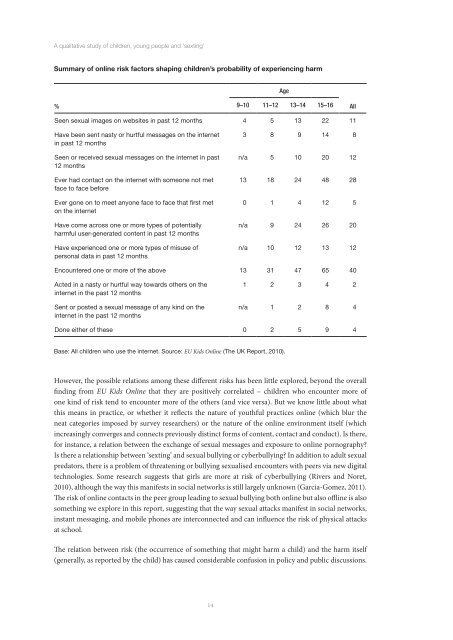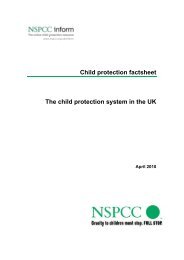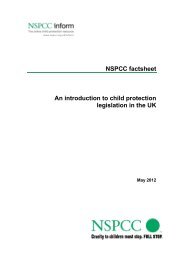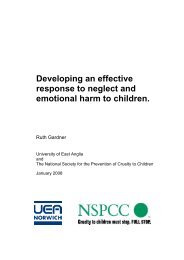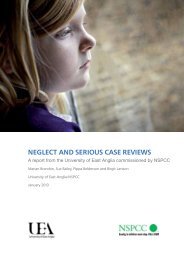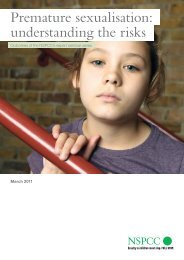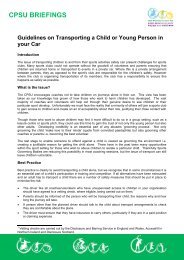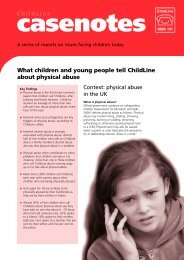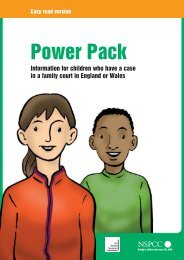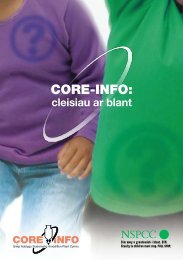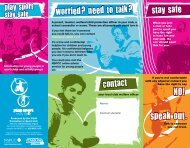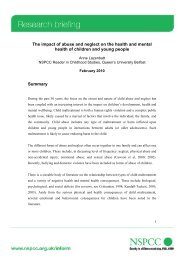A qualitative study of children, young people and 'sexting ... - NSPCC
A qualitative study of children, young people and 'sexting ... - NSPCC
A qualitative study of children, young people and 'sexting ... - NSPCC
You also want an ePaper? Increase the reach of your titles
YUMPU automatically turns print PDFs into web optimized ePapers that Google loves.
A <strong>qualitative</strong> <strong>study</strong> <strong>of</strong> <strong>children</strong>, <strong>young</strong> <strong>people</strong> <strong>and</strong> ‘sexting’<br />
Summary <strong>of</strong> online risk factors shaping <strong>children</strong>’s probability <strong>of</strong> experiencing harm<br />
%<br />
Age<br />
9–10 11–12 13–14 15–16 All<br />
Seen sexual images on websites in past 12 months 4 5 13 22 11<br />
Have been sent nasty or hurtful messages on the internet<br />
in past 12 months<br />
Seen or received sexual messages on the internet in past<br />
12 months<br />
Ever had contact on the internet with someone not met<br />
face to face before<br />
Ever gone on to meet anyone face to face that first met<br />
on the internet<br />
Have come across one or more types <strong>of</strong> potentially<br />
harmful user-generated content in past 12 months<br />
Have experienced one or more types <strong>of</strong> misuse <strong>of</strong><br />
personal data in past 12 months<br />
3 8 9 14 8<br />
n/a 5 10 20 12<br />
13 18 24 48 28<br />
0 1 4 12 5<br />
n/a 9 24 26 20<br />
n/a 10 12 13 12<br />
Encountered one or more <strong>of</strong> the above 13 31 47 65 40<br />
Acted in a nasty or hurtful way towards others on the<br />
internet in the past 12 months<br />
Sent or posted a sexual message <strong>of</strong> any kind on the<br />
internet in the past 12 months<br />
1 2 3 4 2<br />
n/a 1 2 8 4<br />
Done either <strong>of</strong> these 0 2 5 9 4<br />
Base: All <strong>children</strong> who use the internet. Source: EU Kids Online (The UK Report, 2010).<br />
However, the possible relations among these different risks has been little explored, beyond the overall<br />
finding from EU Kids Online that they are positively correlated – <strong>children</strong> who encounter more <strong>of</strong><br />
one kind <strong>of</strong> risk tend to encounter more <strong>of</strong> the others (<strong>and</strong> vice versa). But we know little about what<br />
this means in practice, or whether it reflects the nature <strong>of</strong> youthful practices online (which blur the<br />
neat categories imposed by survey researchers) or the nature <strong>of</strong> the online environment itself (which<br />
increasingly converges <strong>and</strong> connects previously distinct forms <strong>of</strong> content, contact <strong>and</strong> conduct). Is there,<br />
for instance, a relation between the exchange <strong>of</strong> sexual messages <strong>and</strong> exposure to online pornography?<br />
Is there a relationship between ‘sexting’ <strong>and</strong> sexual bullying or cyberbullying? In addition to adult sexual<br />
predators, there is a problem <strong>of</strong> threatening or bullying sexualised encounters with peers via new digital<br />
technologies. Some research suggests that girls are more at risk <strong>of</strong> cyberbullying (Rivers <strong>and</strong> Noret,<br />
2010), although the way this manifests in social networks is still largely unknown (Garcia-Gomez, 2011).<br />
The risk <strong>of</strong> online contacts in the peer group leading to sexual bullying both online but also <strong>of</strong>fline is also<br />
something we explore in this report, suggesting that the way sexual attacks manifest in social networks,<br />
instant messaging, <strong>and</strong> mobile phones are interconnected <strong>and</strong> can influence the risk <strong>of</strong> physical attacks<br />
at school.<br />
The relation between risk (the occurrence <strong>of</strong> something that might harm a child) <strong>and</strong> the harm itself<br />
(generally, as reported by the child) has caused considerable confusion in policy <strong>and</strong> public discussions.<br />
14


